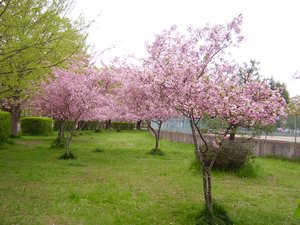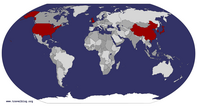Advertisement

 2 Mizusawa Koen
2 Mizusawa Koen
The last of the cherry blossom.Having waved goodbye to LA (but not without sampling the famous cupcakes at Sprinkles, Rodeo Drive, being caught on camera and going to my first Bollywood party); endured the flight to Tokyo, and the train journey to Mizusawa-Esashi station in the middle of nowhere (or so it seemed to me), I made it through my first day in Japan.
I'm in Mizusawa, a town so small it doesn't even register on the blog map (although that's hopefully being remedied as I write). Quaint, pretty and extremely friendly.
I set out mid-morning, on foot, to explore; managed to find the high street, with various fascinatingly unfamiliar shops and restaurants and the train statiion. One highly confused conversation with a long-suffering train master later, and I am armed with a train timetable and the knowledge that I can go where I want to tomorrow without making a reservation.
I then set off at random, and stumbled upon a shrine tucked behind the shopping street. It was also part cemetary and, terrified of committing hubris I didn't stay long, but, in leaving, came across a friendly old lady who tried to tell me something (which of course I didn't understand -
I can't yet manage whole sentences), then looked genuinely disappointed that I couldn't understand her and she couldn't speak enough English to me to make me understand. Still, she made an effort - in fact that is something I have found in all the people I've met here: they are friendly, willing to be approached and willing to approach a stranger and foreigner and talk to them.
(I even found this in Tokyo, where a gentleman approached me, stood looking lost at a juncture in the signposts), and asked me, in perfect English, where I wanted to go and proceeded to direct me there. He wasn't a station employee, just a businessman on his way home during rushour but took the time to help me out.)
After the shrine, I looped back to the tourist information centre (which, as it turns out, was in the station the whole time) and availed myself of a map of the city. Sadly, the map was in Japanese script, as are all the signs here (the signs in Tokyo are written in Romaji - a phonetic transcribing of Japanese in Roman letters - so useful!), but did have useful (and surprisingly accurate)
little drawings of the main sites. The poor lady at the information centre was very patient with me as I pointed at the map and asked her what everything was. My goal was either to recognise a word (such as jinja - shrine, my new word for the day) or to ask her to say the name aloud, so I could write it in Romaji and look it up in my brother's dictionary later.
This latter goal she only partly understood and I found myself writing down something that later turned out to mean plate or dish as she was attempting to describe what the cook-your-own restaurant shown on the map DID rather than what it WAS. Still, she was extremely helpful, and I was able, with the help of the dictionary, some guesswork and a lot of imagination, to get to grips with the map.
The first proper sight I saw was the park (or Koen), which was truly beautiful. I missed the main cherry blossom season, but, as you can see from the pictures, came in time to see some trees still in flower. There was a racetrack which, and Jacqui will be proud of me

 26 pond in park
26 pond in park
Complete with fish.for this, I initially took to be a menage. The most beautiful sight, however, was the shrine.
Knowing this time at least that I was allowed in, I felt more at ease, although I was still paranoid about offending. I know, for example, that you are supposed to cleanse yourself when entering a shrine, but was unclear about where or how. Fortunately, there was a clearly recognisable fountain, with handy pictoral instructions. The shrine was organised into an outer and inner ring. I did not take photographs of the inner ring, where each individual shrine stood, sometimes a whole building for prayer, sometimes just a small wooden stand. Each shrine has a bell outside, with a rope or ribbon (depending on the size of the shrine), that you ring and then pray. I didn't ring any of the bells, feeling it would be disrespectful for a non-believer to do so. I also often saw small dishes and pots outside the shrine as offerings.
The shrines themselves are grouped in a loose circle around the main shrine (which is directly opposite the entrance gate, with a paved pathway leading up to it), creating a sort of courtyard effect. In
the middle of this courtyard were two gorgeous maple tress, with paper knotted around the lower branches. These bits of paper, like the wooden plaques hung from the wall at certain points, are prayers and I saw them outside the inner courtyard as well.
Leaving the shrine, I walked through the rest of the gardens - the colours even on this overcast day were lovely (the photos sadly don't do it justice), especially the pink blossom and the orange and red maples. The gardens were a mixture of unkempt, almost wild grassy areas and beautifully manicured trees. The effect was to make you feel that you were allowed to do things like sit on the grass and relax, whilst enjoying the scenery - there was definitely a feeling of ease that I personally don't find with many formal gardens.
I eventually dragged myself away from the park, and ventured to a supermarket for lunch (pot noodle - living the high life!), before poring over the map again and deciding to explore the Old Quarter (my name) marked on the map. It turns out that my brother's compact little house is bang smack in the middle of an area
with lots of traditional old houses. These were usually gated, and had those characteristic roofs, with the ends that flick up like retrousse noses. Even the most modern houses had lovely manicured gardens, with lots of colour - especially maple trees and a sort of purple magnolia that I hadn't seen before.
After the determined diversity of LA, it was so nice to see a clear homogeneity in the architecture. I also find I really appreciate the compactness of everything, which is particularly noticeable in the cars, and which stands out the more for the contrast with LA. The roads, for example, are often one-track and, more than once, I passed them without realising it.
My wanderings eventually brought me to another shrine - this time in the woods. The inner courtyard was completely surrounded by trees (mostly conifers) and smelled and looked wonderful.
Around this time, the infant and junior schools were ending for the day, so there were suddenly more people on the roads that had essentially been deserted all day. Most adults here glance curiously, with a smile and small bow in return to my greeting (I've been greeting everyone, just in case; I

 15 park shrine
15 park shrine
View of the gateway leading into the inner courtyard. As you can see, the shrine is integrated into the surrounding landscape very well.don't think I've ever been this amenable). The children, however, stare openly in awed fascination, which is a little off-putting at first.
Heading North from the wood shrine, I found a building marked on my map and which I had eventually decided was some sort of memorial or monument. There seemed to be a lot of these in Mizusawa, and I had yet to work out what they were. This one was in some sort of old house, so I took pictures of the outside, but had decided in my timidiy not to go in, when I was greeted (in Japanese) by a gentleman in a suit just getting out of his car. It quickly became obvious that I didn't understand a word he was saying, so he switched into fluent English, and asked me if I had been into the building - which, as it turns out, was a museum.
The gentleman in question turned out to be the chairperson of the Oshu-Mizusawa international relations committee and he took me under his wing. He led me inside and gave me a full tour in English - which I really needed as everything was in Japanese and would
otherwise have been unintelligible to me. It turns out the museum was founded as a memorial to a late Japanese Prime Minister, called Saito-san. He was assassinated on 26 February 1936, a date which, my guide assured me, is engraved on the Japanese psyche. The museum shows the beginnings of his career, his naval background, his political career, his relations with the then Emperor (Saito-san and his wife kept many souvenirs from the Imperial Palace, all distinguishable by the Emperor's crysthanamum mark). Saito-san was also instrumental in the disarmament talks in Europe and so was heavily decorated by the Euoprean powers - including two medals from the Pope.
The museum included artefacts from the assassination itself, including a cracked mirror with a bullet hole in, and the stained bed sheets and nightclothes. The second half of the museum was the house where Saito-san had lived and where his widow returned after his assassination. There was a particularly impressive library, which Saito-san donated to the people of Mizusawa.
After the tour, my guide led me back to the ticket office, where the ladies gave us tea and biscuits, and we tried to make conversation (with my guide acting as

 16 cleansing at the shrine
16 cleansing at the shrine
You use the dipper to pour water over each hand and then into one cupped hand to rinse your mouth before entering the shrine. This one had a towel to dry yourself on afterwards.translator). Everyone was kind and curious and extremely generous with their time. I count myself extremely fortunate.
My guide and I finaaly left, he to go to a business meeting, and myself to continue my explorations, which led me to an old bridge over the river and a lovely walkway past some beautiful traditional houses.
Once my brother was back from work, we went shopping - another new and fascinating experience - and it was sometimes a challenge, trying to work out what the products were. There were many more curious glances with the two of us, particularly as we were talking in English. Although, I must admit, many of the curious glances were mine.
Advertisement
Tot: 0.05s; Tpl: 0.014s; cc: 12; qc: 29; dbt: 0.019s; 1; m:domysql w:travelblog (10.17.0.13); sld: 1;
; mem: 1.1mb





















